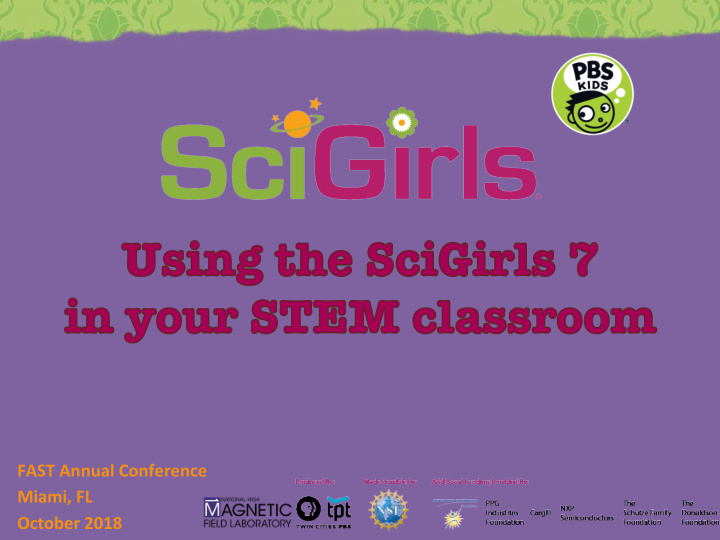



FAST Annual Conference Miami, FL October 2018
• Download the presentation – https://nationalmaglab.org/education Register for this SciGirls training • – https://ngcproject.org/events – FAST Conference Concurrent Session
Media and education that change how girls see STEM and how the world sees girls.
On TV • national PBS Kids series – Online • safe, social networking site – On the Ground • Activities and professional – development A summative evaluation found that girls gained: confidence • a deeper understanding of inquiry • a broadened awareness and interest in • science careers
• Check your local PBS listings OR watch full episodes online – Features real girls doing STEM investigations they’re passionate about – Highlights the science and engineering processes – Features real female STEM professionals
New episodes available now!
pbskids.org/scigirls Mobile friendly website for kids!
Activities for your classroom
• Find your “other half” • Take 5 min. to discuss. – How have you used this strategy? – How could you envision using this strategy in your work?
1. Girls benefit from collaboration, especially when they can participate and communicate fairly. (Parker & Rennie, 2002; Fancsali, 2002) 2. Girls are motivated by projects they find personally relevant and meaningful. (Eisenhart & Finkel, 1998; Thompson & Windschitl, 2005; Liston, Peterson, & Ragan, 2008)
3. Girls enjoy hands-on, open-ended projects and investigations. (Chatman, Nielsen, Strauss, & Tanner, 2008; Burkam, Lee, & Smerdon,1997; Fanscali, 2002) 4. Girls are motivated when they can approach projects in their own way, applying their creativity and unique talents. (Eisenhart & Finkel,1998; Calabrese Barton, Tan, & Rivet, 2008)
5. Girls ’ confidence and performance improves in response to specific, positive feedback on things they can control – such as effort, strategies and behaviors. (Halpern, et al., 2007; Zeldin & Pajares, 2000; Blackwell, Trzesniewski, & Sorich Dweck, 2007; Mueller & Dweck, 1998) 6. Girls gain confidence and trust in their own reasoning when encouraged to think critically. (Chatman, et al., 2008; Eisenhart & Finkel,1998)
7. Girls benefit from relationships with role models and mentors. (Liston, et al., 2008; Evans, Whigham, & Wang, 1995)
Your Group Needs: • Timer Optional (blindfold, folded up coat) •
Educator resources on scigirlsconnect.org Download videos, activities, and other resources to enhance your program!
Think about the activity we did today. How were the SciGirls Seven strategies used today? How can you apply the SciGirls Seven to activities that you already use?
Research/Rationale Review and discuss the graphs using the following questions. • What about the data set pops out or catches your eye? • What about the data encourages you? What about the data concerns you? • What patterns or trends among the data do you see emerging?
Science course enrollment of high school completers 100 90 80 70 60 50 40 30 20 10 0 AP/IB or AP/IB AP/IB AP/IB General No General No General No General advanceds advanced advanced advanced Science biology biology chemistry chemistry physics physics cience biology chemistry physics Male 80.2 19.7 2.7 87.7 9.7 27.1 65.4 7.5 56.7 36.8 6.6 Female 77.1 22.8 2.2 84.5 13.2 21.9 70.2 7.9 60.3 36 3.7
Highest-level mathematics course enrollment of high school completers 30 25 Male Female 20 15 10 5 0 Algebra 1 or Trigonometry or Calculus or Geometry Algebra 2 Pre-calculus lower other higher Male 3.7 9.1 23.7 23.7 20.4 19.5 Female 2.2 6.5 25.1 24 23.2 19.2
Bachelor's Degrees, 2014 120 100 80 60 40 20 0 Engineering Computer Science Mathematics & Physics Biosciences Social Science Statistics Male Female
Employed persons 16 years and older, by occupation, 2015 120 100 80 60 40 20 0 s t t n d r t n t e n s s e s n a e a s i i i e a r o t m i t t i n t a n c t u i n t i i s e e t e n l i s a e e g i h y s i i p c r n c d i h s C D u s s a e d E P c r e n r ' c e s e f a o i t n t l u s g a r i l l o n p i g A c i m e i l r s R a e o y c e c h i n g r P o i g o l n o l E a i B c i t a m e h t a M TABLE 9-1. Employed persons 16 years and older, by detailed occupation: 2006–15 TABLE 9-1. Employed persons 16 years and older, by detailed occupation: 2006–15
What does it all mean? • Boys and girls do not display a significant difference in their abilities in STEM. The cause is social and environmental. Differences consistently appear in girls’ interest and • confidence in STEM subjects, starting at a very young age. These differences can be linked to a negative self- • perception , enhanced by stereotypes.
For Kids: pbskids.org/scigirls For Parents: pbs.org/parents/scigirls For Educators: scigirlsconnect.org For MagLab SciGirls: nationalmaglab.org/education/k12- students/summer-camps/scigirls-blog scigirlstv @SciGirls This material is based upon work supported by the National Science Foundation under Grant No. HRD-1103016. Any opinions, findings, and conclusions or recommendations expressed in this material are those of the author(s) and do not necessarily reflect the views of the National Science Foundation.
Carlos R. Villa Director of K-12 Education Programs Certified Trainer 2018 NSTA Distinguished Informal Science Educator villa@magnet.fsu.edu 850-644-7191
Recommend
More recommend